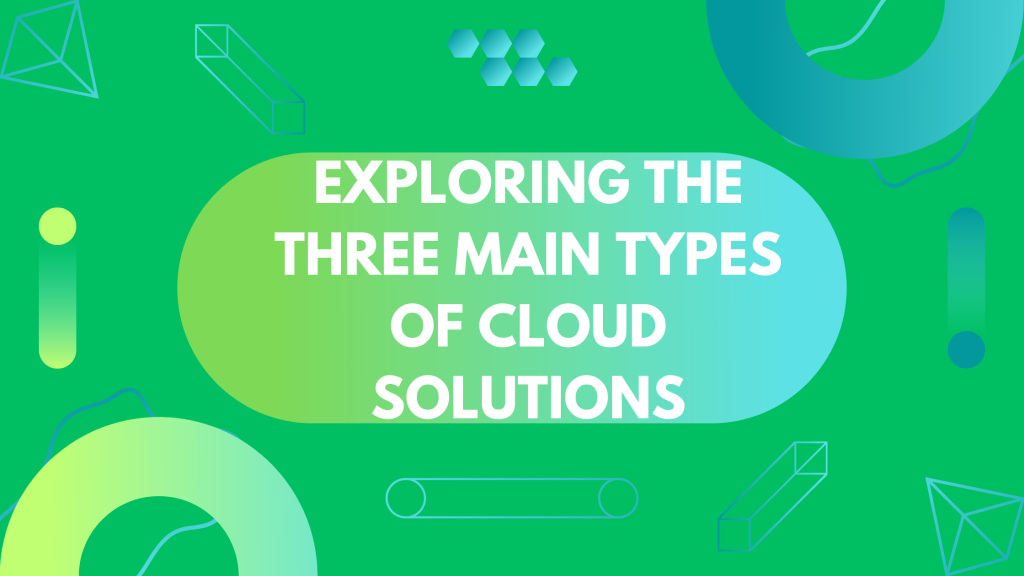Cloud computing has revolutionized how businesses operate by providing scalable, cost-effective, and flexible solutions. Understanding the different types of cloud solutions is essential for organizations looking to leverage the cloud to its fullest potential. The three main types of cloud solutions are Infrastructure as a Service (IaaS), Platform as a Service (PaaS), and Software as a Service (SaaS). Each type offers unique benefits and use cases, making them suitable for varying business needs.
Infrastructure as a Service (IaaS)
Infrastructure as a Service (IaaS) is the most fundamental cloud service model, providing virtualized computing resources over the internet. IaaS allows businesses to rent IT infrastructure, such as virtual machines, storage, and networking, on a pay-as-you-go basis. This model offers significant flexibility and scalability, making it ideal for businesses that need to quickly adapt to changing demands.
Examples of IaaS
- Amazon Web Services (AWS) EC2: AWS Elastic Compute Cloud (EC2) provides resizable compute capacity in the cloud, allowing businesses to scale their applications up or down as needed. EC2 instances can be customized with various configurations of CPU, memory, and storage, making it a versatile solution for different workloads.
- Microsoft Azure Virtual Machines: Azure Virtual Machines offer a wide range of VM configurations, enabling businesses to deploy applications and services quickly. Azure VMs support various operating systems and can integrate seamlessly with other Azure services, providing a comprehensive cloud infrastructure solution.
- Google Cloud Compute Engine: Google Cloud’s Compute Engine delivers scalable and high-performance virtual machines. It offers features such as live migration, automatic restarts, and custom machine types, allowing businesses to optimize their infrastructure for specific needs.
IaaS is particularly beneficial for startups and enterprises that want to avoid the capital expenditure associated with purchasing and maintaining physical hardware. It also provides the flexibility to experiment with new technologies and scale operations without significant upfront investments.
Platform as a Service (PaaS)
Platform as a Service (PaaS) provides a higher level of abstraction compared to IaaS, offering a platform that includes infrastructure, runtime environments, and development tools. PaaS enables developers to build, deploy, and manage applications without worrying about the underlying hardware and software infrastructure. This model accelerates the development process and simplifies application management.
Examples of PaaS
- Google App Engine: Google App Engine is a fully managed platform that allows developers to build and deploy applications using popular programming languages. It automatically handles infrastructure concerns such as scaling, monitoring, and load balancing, enabling developers to focus on writing code.
- Microsoft Azure App Service: Azure App Service is a comprehensive PaaS offering that supports various programming languages and frameworks. It provides built-in DevOps capabilities, integration with Visual Studio, and support for continuous deployment, making it a powerful platform for developing web and mobile applications.
- Heroku: Heroku, a Salesforce company, offers a cloud platform that supports multiple programming languages and frameworks. It provides a simple and intuitive interface for deploying and managing applications, along with a marketplace of add-ons for extending functionality.
PaaS is ideal for development teams that want to streamline their workflow and reduce the complexity of managing infrastructure. It is particularly useful for developing web applications, APIs, and microservices, as it provides the necessary tools and services to support the entire application lifecycle.
Software as a Service (SaaS)
Software as a Service (SaaS) delivers fully functional software applications over the internet, eliminating the need for businesses to install, manage, and maintain software on their own systems. SaaS applications are accessible through web browsers, making them easy to use and deploy. This model offers convenience, scalability, and cost savings, as businesses pay for software on a subscription basis.
Examples of SaaS
- Microsoft Office 365: Office 365 is a suite of productivity applications, including Word, Excel, PowerPoint, and Outlook, delivered as a cloud service. It offers collaboration features, cloud storage, and regular updates, making it a popular choice for businesses of all sizes.
- Salesforce: Salesforce is a leading customer relationship management (CRM) platform that provides tools for sales, marketing, customer service, and more. As a SaaS solution, Salesforce allows businesses to manage customer interactions and data from anywhere, enhancing productivity and customer satisfaction.
- Google Workspace: Google Workspace (formerly G Suite) includes applications such as Gmail, Google Drive, Google Docs, and Google Meet. It offers a unified platform for communication, collaboration, and productivity, making it a valuable tool for remote and distributed teams.
SaaS is particularly advantageous for businesses looking to reduce IT overhead and simplify software management. It provides access to the latest features and security updates, ensuring that users always have the most current and secure versions of the software.
Conclusion
Understanding the three main types of cloud solutions—Infrastructure as a Service (IaaS), Platform as a Service (PaaS), and Software as a Service (SaaS)—is crucial for businesses aiming to leverage the cloud effectively. Each model offers unique benefits and use cases, allowing organizations to choose the right solution based on their specific needs. Whether it’s the flexibility and scalability of IaaS, the streamlined development environment of PaaS, or the convenience and cost savings of SaaS, cloud solutions provide powerful tools to drive innovation and growth.


